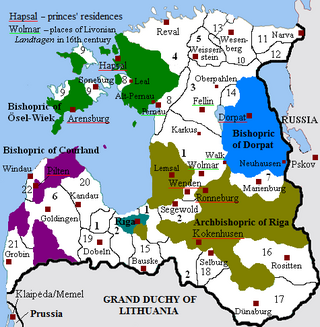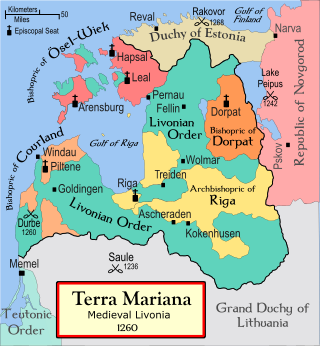
Livonia or in earlier records Livland, is a historical region on the eastern shores of the Baltic Sea. It is named after the Livonians, who lived on the shores of present-day Latvia.
[[File:Facial Chronicle - b.06, p.084 - Battle of the Ice.jpg|thumb|Battle on the Ice on Lake Peipus during the Northern Crusades, miniature from the Illustrated Chronicle of Ivan the Terrible

Courland is one of the Historical Latvian Lands in western Latvia. Courland's largest city is Liepāja, which is the third largest city in Latvia. The regions of Semigallia and Selonia are sometimes considered as part of Courland as they were formerly held by the same duke.

The Duchy of Courland and Semigallia was a duchy in the Baltic region, then known as Livonia, that existed from 1561 to 1569 as a nominally vassal state of the Grand Duchy of Lithuania and subsequently made part of the Crown of the Polish Kingdom from 1569 to 1726 and incorporated into the Polish–Lithuanian Commonwealth in 1726. On March 28, 1795, it was annexed by the Russian Empire in the Third Partition of Poland.

Semigallia, also spelt Semigalia, is one of the Historical Latvian Lands located to the south of the Daugava river and to the north of the Saule region of Samogitia. The territory split between Latvia and Lithuania, previously inhabited by the Semigallian Baltic tribe. They are noted for their long resistance (1219–1290) against the German crusaders and Teutonic Knights during the Northern Crusades. Semigallians had close linguistic and cultural ties with Samogitians.

Aizpute is a town in western Latvia's South Kurzeme Municipality in the valley of the Tebra River, 50 km (31 mi) northeast of Liepāja.

Piltene is a town in northwestern Latvia. The population in 2020 was 909.

The Kingdom of Livonia was a nominal state in what is now the territory of Estonia and Latvia. Russian tsar Ivan IV declared the establishment of the kingdom during the Livonian War of 1558–1583, but it never functioned properly as a polity.

The Bishopric of Courland was the second smallest (4500 km2) ecclesiastical state in the Livonian Confederation founded in the aftermath of the Livonian Crusade. During the Livonian War in 1559 the bishopric became a possession of Denmark, and in 1585 sold by Denmark to Poland–Lithuania.

The Livonian crusade consists of the various military Christianisation campaigns in medieval Livonia – modern Latvia and Estonia – during the Papal-sanctioned Northern Crusades in the 12–13th century. The Livonian crusade was conducted mostly by the Holy Roman Empire and the Kingdom of Denmark. It ended with the creation of Terra Mariana and the Danish duchy of Estonia. The lands on the eastern shores of the Baltic Sea were one of the last parts of Europe to be Christianised.

Grobiņa Castle is a medieval castle located in the town of Grobiņa, in South Kurzeme Municipality in the Courland region of Latvia. The ancient Curonian castle hill is located only 100 m from the castle. It is supposed to be the famous Seeburg, which is mentioned in Scandinavian sources as early as the 9th century.

The ruins of Embūte Castle are located in Embūte, Embūte Parish, South Kurzeme Municipality in the Courland region of Latvia, not far from an ancient hillfort erected by Curonians. It was an ancient Curonian settlement and is mentioned in ancient chronicles as a place with strong Curonian resistance to German crusaders. The bishop's castle was built as a border castle with Lithuania by Livonian Order on a steep hill on the right bank of the Lanka river, which flows into left tributary of the Venta. Later manor house was built using the walls of the former castle, which can be seen in the division of the rooms and the building material. Today, the ruins are surrounded by trees and are in poor condition.

Alsunga Castle is a castle in Alsunga village, in Alsunga Parish, Kuldīga Municipality in the Courland region of Latvia. It was built for the Livonian Order during the first half of the 14th century.

Aizpute Castle is a Livonian Order castle in the town of Aizpute in the historical region of Courland, in western Latvia. It was heavily damaged during the Second Northern War (1655–1660). Since 1998, the castle ruins are a Latvian historical monument.

Dobele Castle is a castle in the town of Dobele in the historical region of Zemgale, Latvia. The Livonian order built the castle on the west bank of the Berze river in 1335, on the site of an old hillfort.

The Treaty of Vilnius or Vilna was concluded on 28 November 1561, during the Livonian War, between the Livonian Confederation and the Grand Duchy of Lithuania in Vilnius. With the treaty, the non-Danish and non-Swedish part of Livonia, with the exception of the Free imperial city of Riga, subjected itself to the Grand Duke of Lithuania, Sigismund II Augustus with the Pacta subiectionis (Provisio ducalis). In turn, Sigismund granted protection from the Tsardom of Russia and confirmed the Livonian estates' traditional privileges, laid out in the Privilegium Sigismundi Augusti.

The Curonians or Kurs were a medieval Baltic tribe living on the shores of the Baltic Sea in the 5th–16th centuries, in what are now western parts of Latvia and Lithuania. They eventually merged with other Baltic tribes contributing to the ethnogenesis of present-day Latvians and Lithuanians. Curonians gave their name to the region of Courland (Kurzeme), and they spoke the Curonian language.

Daugavgrīva Castle is a former monastery converted into a castle, located at Vecdaugava oxbow on right bank of Daugava, in the northern part of Riga city, Latvia. Nowadays here are seen only earthen ramparts.

Dundaga Castle is a medieval castle in Dundaga, in the Talsi Municipality in the Courland region of Latvia. Latvia considers Dundaga Castle to be a monument of archaeological and of architectural importance.

Terra Mariana was the official name for Medieval Livonia or Old Livonia. It was formed in the aftermath of the Livonian Crusade, and its territories were composed of present-day Estonia and Latvia. It was established on 2 February 1207, as a principality of the Holy Roman Empire, and lost this status in 1215 when Pope Innocent III proclaimed it as directly subject to the Holy See.
























